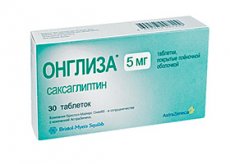Medical expert of the article
New publications
Preparations
Ongliza
Last reviewed: 04.07.2025

All iLive content is medically reviewed or fact checked to ensure as much factual accuracy as possible.
We have strict sourcing guidelines and only link to reputable media sites, academic research institutions and, whenever possible, medically peer reviewed studies. Note that the numbers in parentheses ([1], [2], etc.) are clickable links to these studies.
If you feel that any of our content is inaccurate, out-of-date, or otherwise questionable, please select it and press Ctrl + Enter.

Onglyza is a medicinal product with antidiabetic activity. The medicine contains the active ingredient saxagliptin, which is an extremely powerful selective element with a reversible inhibitory effect of a competitive type on the element dipeptidyl peptidase-4.
The medication is prescribed for use in monotherapy or in combination with other drugs prescribed for the treatment of non-insulin-dependent diabetes mellitus.
Indications Ongliza
It is used in the case of diabetes mellitus type 2 - as a supplement to diet and physical procedures, in order to improve glycemic control. It is usually used in the following schemes:
- conducting monotherapy;
- initial combination therapy with metformin;
- combination with monotherapy using metformin, thiazolidinediones and sulfonylurea derivatives - in the absence of proper glycemic control during such treatment.
Pharmacodynamics
When diabetics take the drug, the activity of the DPP-4 enzyme inside their body is suppressed for a 24-hour period.
After oral glucose intake, as a result of the slowing down of DPP-4 activity, there is a 2-3-fold increase in the values of glucose-dependent insulinotropic polypeptide, as well as glucagon-like peptide-1. In addition, there is a decrease in glucagon indicators and potentiation of the glucose-dependent response of β-cells. Due to this, the level of C-peptide increases in the body along with insulin.
The release of insulin through pancreatic β-cells, as well as the weakening of glucagon release from pancreatic α-cells, causes a decrease in fasting glycemia, as well as a decrease in postprandial glycemia.
Taking saxagliptin does not cause weight gain in patients.
 [ 3 ]
[ 3 ]
Pharmacokinetics
Saxagliptin is absorbed at a high rate inside the body when taken before meals. When administered orally, approximately 75% of the dose is absorbed. Saxagliptin and its metabolic element are synthesized rather weakly with blood protein.
Plasma Cmax values of saxagliptin together with its main metabolic component are recorded after 2 and 4 hours, respectively.
The average terminal half-life of the substance and metabolite is 2.5 and 3.1 hours, respectively. Excretion occurs with urine and bile.
 [ 4 ]
[ 4 ]
Dosing and administration
The medication is taken orally, without regard to food intake.
When conducting monotherapy, Onglyza is used in a dosage of 5 mg of the substance once a day.
In case of complex therapy, metformin, sulfonylurea derivatives or thiazolidinediones should be taken together with 5 mg of the drug (1 time per day).
At the initial stage of therapy in combination with metformin, the dose of the drug is 5 mg, and the dosage of metformin is 0.5 g per day.
If you miss a dose, take it as soon as you remember. Do not take a double dose.
People with severe or moderate renal insufficiency, as well as people undergoing hemodialysis procedures, should take 2.5 mg of the substance per day. The intake should be carried out after the hemodialysis session.
When used with potent CYP 3A4/5 inhibitors, the Onglyza serving size should be 2.5 mg per day.
 [ 6 ]
[ 6 ]
Use Ongliza during pregnancy
Due to the lack of data regarding the use of saxagliptin during breastfeeding and pregnancy, the drug is not used during these periods.
Contraindications
Main contraindications:
- diabetes mellitus type 1;
- use of the drug together with insulin;
- lactose intolerance, galactosemia, congenital glucose-galactose malabsorption;
- ketoacidosis of diabetic origin;
- hypersensitivity associated with the components of the drug.
It should be used with extreme caution in individuals with renal impairment (severe or moderate), the elderly, and patients taking sulfonylurea derivatives.
 [ 5 ]
[ 5 ]
Side effects Ongliza
Possible side effects include:
- infections affecting the upper respiratory tract or urinary tract;
- sinusitis;
- vomiting or gastroenteritis;
- headaches.
When combining the drug with metformin, headaches or nasopharyngitis may occur.
Interactions with other drugs
The data obtained from testing showed that significant interactions of the drug with other drugs develop only in isolated cases.
Combination with substances that induce CYP 3A4/5 isoenzymes (including rifampicin with carbamazepine, dexamethasone, and phenytoin with phenobarbital) may reduce the levels of the main metabolic element of saxagliptin.
Because sulfonylurea derivatives can lead to the development of hypoglycemia, a reduction in the dosage of sulfonylurea derivatives may be required to reduce this risk when combined with Onglyza.
Attention!
To simplify the perception of information, this instruction for use of the drug "Ongliza" translated and presented in a special form on the basis of the official instructions for medical use of the drug. Before use read the annotation that came directly to medicines.
Description provided for informational purposes and is not a guide to self-healing. The need for this drug, the purpose of the treatment regimen, methods and dose of the drug is determined solely by the attending physician. Self-medication is dangerous for your health.

